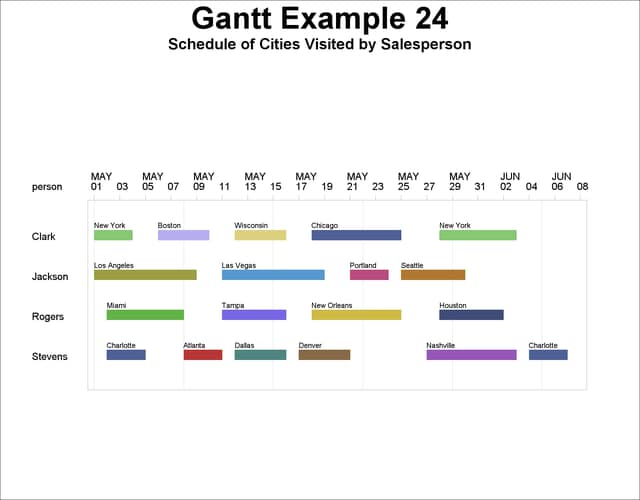| The GANTT Procedure |
Example 8.24 Multisegment Gantt Charts
The following is a simple example that illustrates the generation of multisegmented Gantt charts. The SCHED data set identifies the city, the arrival time, and the departure time for each of four traveling salespeople. In addition, a _PATTERN variable is used to identify the pattern to be used for drawing the bar. The objective is to display the complete schedule for each sales person on a single row. This would require displaying several bars on a single row, each bar corresponding to the time spent in a city. In order to do this, you need first to sort the SCHED data set by Salesperson and Arrival Time and then to add a SEGMT_NO variable that identifies the number of the segment that, in this case, is the order in which the salesperson visits the city. The resulting data set, NEWSCHED, is shown in Output 8.24.1. You next create the LABELS data set in order to identify the names of the cities above the bars; the resulting Gantt chart is shown in Output 8.24.2.
Notice that each bar is drawn using the pattern identified by the _PATTERN variable in the SCHED data set. In the absence of the _PATTERN variable, the pattern associated with the resource-constrained schedule would have been used for all the bars. This is the same mechanism that produced the split segments in Example 8.13 although the SEGMT_NO variable in this case was automatically created by the CPM procedure.
data sched; format city $12. from to date7. ; input person $ city & from & date7. to & date7. _pattern; datalines; Clark New York 01May04 03May04 10 Clark Boston 06May04 09May04 11 Clark Wisconsin 12May04 15May04 12 Clark Chicago 18May04 24May04 13 Clark New York 28May04 02Jun04 10 Stevens Charlotte 02May04 04May04 14 Stevens Atlanta 08May04 10May04 15 Stevens Dallas 12May04 15May04 16 Stevens Denver 17May04 20May04 17 Stevens Nashville 27May04 02Jun04 18 Stevens Charlotte 04Jun04 06Jun04 14 Jackson Los Angeles 01May04 08May04 19 Jackson Las Vegas 11May04 18May04 20 Jackson Portland 21May04 23May04 21 Jackson Seattle 25May04 29May04 22 Rogers Miami 02May04 07May04 23 Rogers Tampa 11May04 15May04 24 Rogers New Orleans 18May04 24May04 25 Rogers Houston 28May04 01Jun04 26 ;
/* Sort data by person, from */ proc sort data=sched; by person from; run;
/* Add Segmt_no variable */ data newsched; set sched; retain segmt_no; if person ne lag(person) then segmt_no=1; else segmt_no = segmt_no + 1; output; run;
proc print data=newsched; title2 'Data NEWSCHED'; run;
data labels; _y=-1; _lvar="city"; _xvar="from"; _flabel=""; _hlabel=0.75; _yoffset = -.2; run;
* set up required pattern statements;
pattern1 v=s r=25;
title1 'Gantt Example 24';
title2 'Schedule of Cities Visited by Salesperson';
proc gantt graphics data=newsched labdata=labels;
id person;
chart / ss=from sf=to compress labsplit='.' scale=2
nolegend nojobnum skip=3
ref='01may04'd to '30jun04'd by week;
run;
| Data NEWSCHED |
| Obs | city | from | to | person | _pattern | segmt_no |
|---|---|---|---|---|---|---|
| 1 | New York | 01MAY04 | 03MAY04 | Clark | 10 | 1 |
| 2 | Boston | 06MAY04 | 09MAY04 | Clark | 11 | 2 |
| 3 | Wisconsin | 12MAY04 | 15MAY04 | Clark | 12 | 3 |
| 4 | Chicago | 18MAY04 | 24MAY04 | Clark | 13 | 4 |
| 5 | New York | 28MAY04 | 02JUN04 | Clark | 10 | 5 |
| 6 | Los Angeles | 01MAY04 | 08MAY04 | Jackson | 19 | 1 |
| 7 | Las Vegas | 11MAY04 | 18MAY04 | Jackson | 20 | 2 |
| 8 | Portland | 21MAY04 | 23MAY04 | Jackson | 21 | 3 |
| 9 | Seattle | 25MAY04 | 29MAY04 | Jackson | 22 | 4 |
| 10 | Miami | 02MAY04 | 07MAY04 | Rogers | 23 | 1 |
| 11 | Tampa | 11MAY04 | 15MAY04 | Rogers | 24 | 2 |
| 12 | New Orleans | 18MAY04 | 24MAY04 | Rogers | 25 | 3 |
| 13 | Houston | 28MAY04 | 01JUN04 | Rogers | 26 | 4 |
| 14 | Charlotte | 02MAY04 | 04MAY04 | Stevens | 14 | 1 |
| 15 | Atlanta | 08MAY04 | 10MAY04 | Stevens | 15 | 2 |
| 16 | Dallas | 12MAY04 | 15MAY04 | Stevens | 16 | 3 |
| 17 | Denver | 17MAY04 | 20MAY04 | Stevens | 17 | 4 |
| 18 | Nashville | 27MAY04 | 02JUN04 | Stevens | 18 | 5 |
| 19 | Charlotte | 04JUN04 | 06JUN04 | Stevens | 14 | 6 |

Copyright © SAS Institute, Inc. All Rights Reserved.